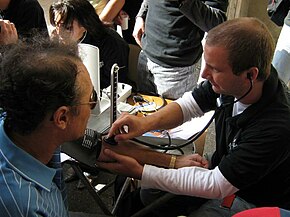
Back قياسات ضغط الدم Arabic Měření krevního tlaku Czech Blodtryksmåling Danish Blutdruckmessung German Đo huyết áp Vietnamese
| Blood pressure measurement | |
|---|---|
 A medical student checking blood pressure using a sphygmomanometer and stethoscope. | |
| Test of | Blood pressure |
| Based on | CNAP vascular unloading technique |
| MedlinePlus | 007490 |
Arterial blood pressure is most commonly measured via a sphygmomanometer, which historically used the height of a column of mercury to reflect the circulating pressure.[1] Blood pressure values are generally reported in millimetres of mercury (mmHg), though modern aneroid and electronic devices do not contain mercury.
For each heartbeat, blood pressure varies between systolic and diastolic pressures. Systolic pressure is peak pressure in the arteries, which occurs near the end of the cardiac cycle when the ventricles are contracting. Diastolic pressure is minimum pressure in the arteries, which occurs near the beginning of the cardiac cycle when the ventricles are filled with blood. An example of normal measured values for a resting, healthy adult human is 120 mmHg systolic and 80 mmHg diastolic (written as 120/80 mmHg, and spoken as "one-twenty over eighty"). The difference between the systolic and diastolic pressures is referred to as pulse pressure (not to be confused with pulse rate/heartrate) and has clinical significance in a wide variety of situations. It is generally measured by first determining the systolic and diastolic pressures and then subtracting the diastolic from the systolic.[2][3][4][5] Mean arterial pressure is the average pressure during a single cardiac cycle and, although it is possible to measure directly using an arterial catheter, it is more commonly estimated indirectly using one of several different mathematical formulas once systolic, diastolic, and pulse pressures are known.[6]
Systolic and diastolic arterial blood pressures are not static but undergo natural variations[7] from one heartbeat to another and throughout the day (in a circadian rhythm). They also change in response to stress, nutritional factors, drugs, disease, exercise, and momentarily from standing up. Sometimes the variations are large. Hypertension refers to arterial pressure being abnormally high, as opposed to hypotension, when it is abnormally low. Along with body temperature, respiratory rate, and pulse rate, blood pressure is one of the four main vital signs routinely monitored by medical professionals and healthcare providers.[8]
Measuring pressure invasively, by penetrating the arterial wall to take the measurement, is much less common and usually restricted to a hospital setting.
- ^ Booth J (1977). "A short history of blood pressure measurement". Proceedings of the Royal Society of Medicine. 70 (11): 793–799. doi:10.1177/003591577707001112. PMC 1543468. PMID 341169.
- ^ Homan TD, Bordes SJ, Cichowski E (12 July 2022). "Physiology, Pulse Pressure". StatPearls [Internet]. Treasure Island (FL): StatPearls Publishing. PMID 29494015. Retrieved 2019-07-21 – via NCBI Bookshelf.
- ^ Franklin, Stanley S.; Khan, Shehzad A.; Wong, Nathan D.; Larson, Martin G.; Levy, Daniel (27 Jul 1999). "Is Pulse Pressure Useful in Predicting Risk for Coronary Heart Disease?". Circulation. 100 (4). Ovid Technologies (Wolters Kluwer Health): 354–360. doi:10.1161/01.cir.100.4.354. ISSN 0009-7322. PMID 10421594.
- ^ Benetos, Athanase; Safar, Michel; Rudnichi, Annie; Smulyan, Harold; Richard, Jacques-Lucien; Ducimetière, Pierre; Guize, Louis (1997). "Pulse Pressure". Hypertension. 30 (6). Ovid Technologies (Wolters Kluwer Health): 1410–1415. doi:10.1161/01.hyp.30.6.1410. ISSN 0194-911X. PMID 9403561.
- ^ Khilnani P, Singhi S, Lodha R, Santhanam I, Sachdev A, Chugh K, Jaishree M, Ranjit S, Ramachandran B, Ali U, Udani S, Uttam R, Deopujari S (January 2010). "Pediatric Sepsis Guidelines: Summary for resource-limited countries". Indian J Crit Care Med. 14 (1): 41–52. doi:10.4103/0972-5229.63029. PMC 2888329. PMID 20606908.
- ^ Zheng L, Sun Z, Li J, Zhang R, Zhang X, Liu S, et al. (July 2008). "Pulse pressure and mean arterial pressure in relation to ischemic stroke among patients with uncontrolled hypertension in rural areas of China". Stroke. 39 (7): 1932–1937. doi:10.1161/STROKEAHA.107.510677. PMID 18451345.
- ^ "Blood pressure measurement: MedlinePlus Medical Encyclopedia". medlineplus.gov. Retrieved 2020-04-30.
- ^ "Vital Signs (Body Temperature, Pulse Rate, Respiration Rate, Blood Pressure)". OHSU Health Information. Oregon Health & Science University. Retrieved 2014-04-16.